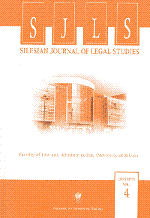


Keywords: subregions; socio-economic situation; Lower Silesia
In this article an analysis of the economic situation occurring in the subregions of Lower Silesia was carried out. These subregions were classified according to the nomenclature of territorial units for statistics (NUTS) at the level NUTS 3. An attempt was also made to demonstrate the internal differences occurring in the region. The following figures were subject to this study: the expenditure and revenue budgets per capita, unemployment rate, average monthly gross wage, the number of entities and individuals registered and newly registered in the REGON register, capital expenditure and the gross value of fixed assets in enterprises. The study gathered data series for 2008 and 2010.
More...

Keywords: Moravia; administration; czech republic; legal history
More...
Keywords: magic thinking; social memory; connotation; constructivism; Teschen Silesia
The aim of the paper is to consider such ethnolinguistic categories as magic, connotation, and cognitive blending as possible keys to the following questions: How is it possible that we can perfectly adopt different representations of the past and internalize them as our past? How can we reconcile different representations of the past and how is it possible that diverse representations of the past merge in one social memory? Such amalgamations of various forms of representations and diverse scales of objectification can be clarified by means of the theory of magic, by means of the law of resemblance, and the law of contiguity. Such considerations are supported here by empirical study of the construction of social memories in Teschen Silesia, which was divided between Poland and Czechoslovakia in 1920. On both sides of the new border different state institutions emerged and influenced local memories.
More...
Keywords: corporate social responsibility; value drivers; stakeholders; environmental preferences
Strategic CSR is implemented when social and/or environmental expenses help achieve economic purpose of an enterprise. This depends on actual potential of environmental preferences of enterprise stakeholders to modify firm’s value drivers. An analysis of environmental preferences of inhabitants of Silesia region demonstrates that polled individuals are not likely to reward CSR either as consumers or as investors, which is unfavorable for the implementation of strategic CSR. Defining a target group, which an enterprise could address strategic CSR to, is a very difficult task. Thereof it can be stated that strategic CSR is not likely to be successful in Silesia, unless targeted to very well recognized, specific stakeholders. For that reason enterprises which adopt CSR can do it as non-for-profit CSR or incur agency cost.
More...
Keywords: urbanisation; metropolisation; metropolis; regionalism; government
In its methodological context, the article, expands on the idea of the organization of the "Silesia" superstructure. The idea of establishing a common urban organism emerged with the local governments of the Upper Silesian conurbation cities and was dictated by the need to find a way to change the traditional image of the Silesian region and its post-industrial role in the economic space of the country, as well as Europe. Therefore, in 2009, the Metropolitan Association of Upper- Silesia, an association for the initial institutionalization of "Silesia", was registered, because "Silesia" does not hold any administrative or legal force. Such an organizational "revolution" of the Upper Silesian conurbation initiated a wide social debate, in which the arguments of both supporters and opponents of such an enterprise in the Silesian region became apparent, together with misunderstandings related to the term "metropolis", and the idea of establishing "Silesia". Representatives of local governments chose the more prestigious term "metropolis" as if a complex metropolisation had taken place in the Upper Silesian conurbation. It would be adequate, however, to look only for the first features of metropolitan functions in this de-industrialized and restructured region, which are going to shape the longlasting metropolisation process under the influence of globalisation
More...Keywords: dual citizenship; Opole Silesia; Germany; Poland; European Union;
In Poland’s region of Opole Silesia, ethnic Germans constitute one-third of the populace. Most of them (re-)acquired German citizenship in the 1990s. This also meant obtaining EU citizenship. Thus, they form the largest compact group of German/EU citizens residing outside Germany/the EU. Should Poland join the EU with too long a derogation period on the free movement of its citizens throughout the Union, it would create EU citizenship of two classes in Opole Silesia. With the full set of privileges for German citizens and a restricted one for Polish citizens. I argue that it may lead to resurfacing of the nationalist tension with widespread international repercussions.
More...
Keywords: university; ranking; higher education; strategy; management.
University rankings are extremely important not only for future student, but also for universities themselves. They have a large impact on the institutions of higher education. A lot of universities believe, that rankings help them to maintain and create a reputation. Ranking systems function as some kind of fashion arena, where universities make comparisons between themselves. Universities want to improve their position in published classifications, so very often they try to change their policy and strategy. They also try to influence the ranking indicators, for example by hiring Nobel Prize winners. Therefore, there is an increasing need for reliable and transparent information about schools. However universities need not only statistical data, but also the tools, which will be useful in their comparisons and evaluations. The article presents the possibility of using one of the methods of graphic presentation of multidimensional empirical data structure, so called RGM, proposed by M. Rybaczuk. Thanks to this method universities could easily compare one another. They also could identify the fields of their activities, in which they are able to be better. The proposed way of graphical presentation of the universities could be a useful addition to traditional rankings, which just show us a lists of schools from the best to the worst.
More...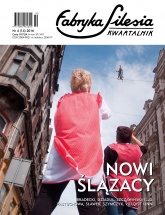
Keywords: Silesia
They uphold memory, study history, revive multiculturalism, care for tradition and dialect, care for public space or simply animate cultural life. The new Silesians.
More...
Keywords: innovations;innovative organization;university;
The article defines a university as one of the key innovative organizations regarding the societal needs. It identifies the sources of innovations in the univer-sity setting and determines a critical role and competences of a chief executive for the innovation potential of an institution from the perspective of an organization management. It also addresses the issue of barriers and institution resistance to in-novations, mainly in light of conservative management, and the issue of financing innovations in general.
More...
Keywords: silesia;industry;postindustrial areas;
WALDEMAR SZYMCZYK in conversation with MAREK S. SZCZEPAŃSKI, sociologist Z socjologiem prof. MARKIEM S. SZCZEPAŃSKIM rozmawia WALDEMAR SZYMCZYK
More...
Keywords: tourism;culinary tourism;Silesia;
The culinary tourism is an indelible part of the cultural tourist, it is also a developed branch of the gastronomy. The majority of people practicing this form of the tourism seek gustatory experiences, want to explore their knowledge about a given product, the kitchen of a given region and purchase unique products. Currently it is a highly recommended form of the tourism, it is very popular in western Europe and over the world and it is getting to be more popular in Poland as well. But culinary tourism is still developing, but it is noticed that more and more people are interested in it. Author of the paper wants to prove that the Silesian regional cuisine has a lot of potential and could be a showcase of Upper Silesia as one of the main tourism attractions of this region for both locals and tourists of other Polish regions and foreigners as well.
More...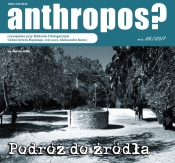
Keywords: silesia;film;local identity;
The aim of the article is the analysis of the issue of the place, local identity, individual memory in the most recent Silesian movies: My Niemandsland (directed by Wojciech Królikowski, 2016) and Stars (directed by Jan Kidawa-Błoński, 2017). In those works draw attention different perspective on Silesia as geocultural region and originality of approach to the subject of locality, which suggest wider interpretation - the change of attitude that takes place in contemporary cultural representations. There is visible not only a tendency to overcome the stereotypes, but also placing emphasis on 'borderland' as a feature of a space and as a syndrome of a particular psycho-cultural attitude characteristic for citizens of 'borderland'. The way of presenting of Silesianity in the analysed films depicts critical approach to the place, taking into account features necessary to its opening, inner dynamics and processuality (constant expansion).
More...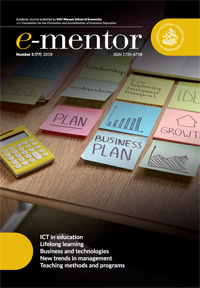
Keywords: university; social responsibility; social commitment; social responsibility strategy of a university; sustainable development
As the social responsibility notion developed, it caught the interest of not only businesses but also other organizations, including universities. The project described in the article aimed at researching how higher education institutions develop their social responsibility strategies. The desk research carried out covered the analysis of GRI database entries where the universities’ social responsibility and sustainable development reports are stored as well as the analysis of selected reports and universities’ websites. The two main findings of that research are: the growing social responsibility of the universities has been proved, and a vast diversity of the strategies applied was observed. As a result, seven models of creating the university strategy have been identified and described in the paper. In conclusion, we must stress that there are no universal standards regarding the placement of the strategy in the university general development plans, neither its scope, the process of creation nor the way it is communicated.
More...
Keywords: administration during occupation; Third Reich; taxes; tax law
The article concerns the attitude of the occupation administration of the Third Reich introduced in Upper Silesia in September 1939 to the issue of income tax for 1939. The article discusses the analysis of Polish legislation and jurisprudence in the field of tax law carried out by German officials, the proposed regulation, its motives and the final solution. The considerations concerning Polish income tax were preceded by the presentation of analogous measures taken by Germany in connection with the incorporation of Austria and the Sudetenland.
More...
Keywords: university; university teachers; values; competences; students; survey
Objective: The paper deals with the theoretical and empirical examination of university values in relation to key competences of university teachers. The combination of values that universities should prioritize and the competences that university teachers should possess is seen inthe paper as an important precondition for improving the quality and acceleration of modern university progress. The theoretical part analyzes, compares and synthesizes opinions on key terms examined in the paper, i.e. higher education, university, values, and competences. The empirical part presents, on the one hand, the results of the questionnaire survey aimed at defining important university values. The survey was carried out on a sample of n = 279 students of the University of Žilina, Slovak Republic, and obtained 1,786 statements on crucial values orsub-values of the university. On the other hand, based on results of the previous survey (n = 27 university teachers) which was targeted on key competences of the great university teachers, the empirical part seeks to experimentally link university key values with teachers’ key competences. Methodology: Analysis, synthesis, comparison, abstraction, questionnaire survey, thinking experiment. Hypothesis H1: University values defined by students will be repeated in the survey,i.e. student views on the core values of university will be identical or similar in content. Negationhypothesis H0: University values defined by students will not be repeated in the survey. Findings: Respondents reported a total of n0 = 1,786 statements regarding the university valuesor sub-values. A substantial consensus was found: many of values were repeated for respondents. Defined values were subsequently grouped: from the initially defined n1 = 229 values, n2= 32 complex values were generated. This leads to a rejection of H0, in favor of H1: the universityvalues generated by students are similar in the content.The results in the evaluative question confirmed the assumption that respondents considered most important mostly those values that the previous open question most frequently reported. Although depending on the study program is always the quality of education in the first placeof importance, the order of importance of other values varies to some extent. Value Added: Opinions on university teachers’ competences and university’s values were discussed. Experimental linking of university values to competences of teachers was performed based on the survey results conducted by the authors in 2012 (this one consisted of three sequential interviews/workshops with teachers of University of Žilina). A logical conclusion was formulated: All the university teachers and scientists are becoming authorities competent to build, preserve and transform universal knowledge into an ever-higher level. Recommendations: A conclusion of the paper contains the characteristics recommended for achieve an effective process of developing university competences.
More...
Keywords: ecumenism; Cieszyn Silesia; ecumenism; Second Vatican Council; history; reception
There are certain places throughout the world where ecumenical movements are born and have arisen out of the very essence the sociocultural realities of these places. The Cieszyn region of Silesia is such a place. In Cieszyn, different nationalities, cultures, and religions converge because the region both literally and symbolically contains many borders. Many Christian denominations peacefully coexist within Cieszyn, which is home to the largest community of Lutherans in Poland. The ecumenical movement within Cieszyn arose as a necessary and inevitable consequence of the coexistence of these Churches. For this reason, the Cieszyn region of Silesia is a perfect example of contemporary trends that are occurring within the ecumenical movement. Ecumenism in the Cieszyn region of Silesia has a very long and rich history that began more than five centuries ago, meaning long before the Second Vatican Council issued the Decree on Ecumenism Unitatis Redintegratio. Two Christian denominations—Roman Catholic and Lutheran—have coexisted in Cieszyn Silesia and, therefore, have become a symbol of an ecumenism based on faith and tolerance as well as survival and respect. Each of these represent the modern understanding of ecumenism today. The ecumenical movement can serve as a solid foundation that strengthens a sense of unity within local communities that share the same cultural and Christian roots so that these communities can achieve a common goal: to build a civilization of love, peace, and justice. Based on the examples of ecumenical relationships at work provided in this article, it is possible to say that the wise of “today” look back on “yesterday” in order to build a better “tomorrow.” Therefore, it is safe to assert that an ecumenism well-lived in the present that is also firmly rooted in history is a source of hope for the future of Christian Churches and communities. When presenting how the multi-denominational population of Cieszyn Silesia received the Decree on Ecumenism Unitatis Redintegratio, a statement made by one of the most eminent Polish ecumenists, Father Prof. Wacław Hryniewicz, comes to mind: “An authentic reception can be achieved only when the partners differ from each other, because diversity enables the true relationship between giving and taking.”
More...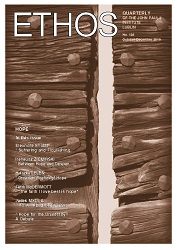
Keywords: university; the academic ethos; academic freedom; objectification of research and teaching; utilitarian axiology;
The author claims that the ongoing controversy over the functioning of the university is essentially of an axiological and anthropological nature. The paradox, described by Tadeusz Kotarbiński, of the academic freedom which characterized clandestine education organized during the Nazi occupation in Poland, provides the background against which the author presents threats posed by reductionist technocratic anthropology and utilitarian axiology inherent in the currently promoted model of the university as a provider of educational services. According to the author, the progressing objectification of research and teaching results in an atrophy of selflessness, a quality indispensable in this type of activity, while perceiving university as a product to be marketed undermines the world of academic values. Due to bureaucratic overregulation, researchers and teachers are coerced into attempts at quantification of their, essentially unquantifiable, intellectual effort. The author expresses also his anxiety about the demand for university professors to take responsibility for the ‘upbringing’ of their students, i.e., about the expectation that students should be involved in activities which are oversimplistic in the case of individuals capable of selfeducation. According to the author, such ‘belated’ attempts at psychological training tend to prove counterproductive and actually encourage immaturity on the part of the students. The author also argues that the system of a militarylike discipline imposed on the university contributes to the destruction of its autonomy and that the teaching methods recommended in the official guidelines would be damaging to the intellectual and spiritual culture and to the ethos of the university. In the author’s opinion, education divorced from the selfless pursuit of truth is bound to produce ‘closed minds,’ incapable of a pursuit of truth.
More...
Keywords: Silesian ethnolect; Czech language; Polish language; mixed languages; ponašymu; code-switching; Těšín Silesia; Zaolzie region;
This article describes the development of the linguistic situation in the border region of Těšín Silesia throughout its history, with particular emphasis on the so-called ponašymu – a mixed language code used in the Czech part of the region. It is based on a random combination of forms of the traditional Těšín dialect with the standard Czech language and, to a lesser extent, elements borrowed from the Polish and Slovak languages and from neighbouring Moravian dialects. An important element of the study is the analysis of selected material collected by the author during fieldwork in August 2018.
More...